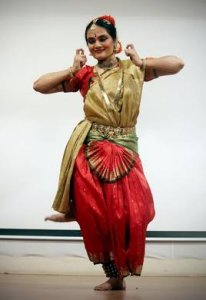
|   |

|   |
Spirituality in classical dance - Dr. S D Desai e-mail: sureshmrudula@yahoo.co.in Pics: Gayatri Vaidya October 9, 2013 The spiritual import of Indian classical dance is a given. With a numerical explosion of dance centres, performers and performances today, and the use of modern technologies at public performances, a feel of this association is either completely lost or it comes across in varying degrees from region to region. Dr. Uma Anantani, a Kanak Rele disciple and director, Rasadhwani (Ahmedabad), made a power-point presentation followed by a four-unit Bharatanatyam dance performance by Shivangee Vikram, her daughter and a Nalanda student, with the focus on this association at Vishwakosh Bhavan’s Lalit Kala Kendra, which has been buzzing with such art related activities.  The solo performer Shivangee, in elegant aharya, with absolute grace, poise and control of lines remained focussed on the theme all through. Spirituality is integral to Bharatanatyam and a natural exponent like her does not need to make an effort to bring it to her performance. With competent musical accompaniment by Jayan Nair and Amit Thakkar, she gave the largely uninitiated but appreciative viewers, a pleasing feel of it in Dr. Anantani’s choreography (one was by Dr Rele) and direction.  Her invocatory piece Nrityanjali with the background chant pushpa naivedya danebhyo nritta danam vishishtate set the tone and anticipation. This was followed by Ganapati-atharva-sheersha. The third invocatory piece, in alarippu format, was a response prompted by a Ganesh Yantra mantra. When one is set out for even a worldly goal Lord Ganesh, as we know, is believed to clear and smoothen the path of all possible obstacles and release the right energy in the pursuer of the path. In controlled languid movement with gesture, Shivangee conjures up in Dr. Kanak Rele’s choreography the samoda-Damodara’s sensual play with the Gopis in Kavi Jayadev’s madhura padavali: chandana charchita neela kalevara peeta vasana vanamali... Lord Vishnu’s consort Lakshmi, source of energy and delicacy combined with prosperity, characteristically enters in the third unit on the contemporary musical waves created by a ‘Yodhakaa’ experimental composition. The intermittent serene silences and short lines in Shivangee’s own voice left a soothing cherished impact. In the meditative tillana, the performance culminated in a flowing visualization of noted Gujarati poet Rajendra Shukla’s lines, in which his syllables celebrating the nirguna form of the divine resonate ethereal aural beauty: Tann Tann Tom Tom: Neekat Prakat Rom Rom
Neerakha Prathak Dom Dom: Dhadhak Dhadhak Dhom Dhom Vihar Vihar Vyom Vyom: Akath Akath OM OM In the modern times when the spiritual aspect of classical dance looks fading and audiences seem not relating to it, Dr. Anantani’s was a welcome modest initiative. The presentation part of it though left a feeling that a more crisp, compact and well articulated intermittent observations introducing and coordinating the units in the light of the theme spelt out as ‘Significance of spirituality in Indian classical dance – Vedic, Vedantic and Bhakti traditions’ would have further enhanced the quality of the program. Dr. SD Desai, a professor of English, has been a Performing Arts Critic for many years. Among the dance journals he has contributed to are Narthaki, Sruti, Nartanam and Attendance. He guest-edited Attendance 2013 Special Issue. His books have been published by Gujarat Sahitya Academy, Oxford University Press and Rupa. After 30 years with a national English daily, he is now a freelance art writer. |